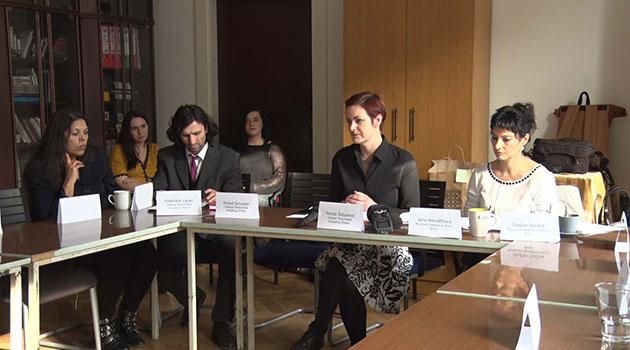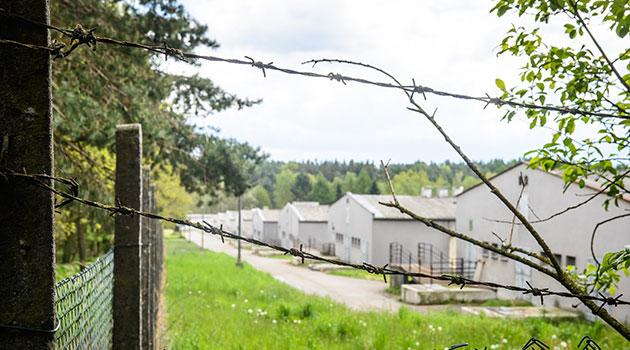Czech round table on Romani genocide memorial: Relatives of victims must have the last word

Almost 30 people from various fields gathered on 26 January 2018 at the invitation of the Terezín Initiative Institute and the Museum of Romani Culture for a round table at the Institute’s headquarters in the building of the former Jewish school on Jáchymova Street in Prague to discuss the possible creation of a Lety Platform that would, as a working group, discuss the form of the future remembrance site at Lety u Písku. In addition to representatives of both these institutions (historians and professional staff), there were representatives of the Office of the Government, the Czech Government Council for Romani Minority Affairs, the Czech Culture Ministry, activists, and naturally the relatives of the victims of the camp at Lety and the camp at Hodonín u Kunštátu.
Given that the Museum had taken over administration of the Hodonín u Kunštátu Memorial the day before, Museum director Jana Horváthová first familiarized those present with the current state of memorial. In addition to needing to resolve some technical deficiencies of the buildings, it will be a big challenge for the Museum to complete the exhibitions before opening the memorial to the public.
The Museum has taken over the exhibitions designed by the previous administrator of the facility, the Comenius National Pedagogical Museum and Library, in graphic design form, the final versions of which have not yet been produced for exhibition – fortunately, as it turns out. It will be necessary to redesign the exhibitions and it is already certain that they will have to be reworked, at least partially, to be in accordance with current knowledge and with the philosophy of the Museum of Romani Culture as the administrator.
Horváthová asked for the active collaboration of representatives of the relatives of those imprisoned at Hodonín u Kunštátu in this matter. For some at the round table it was absolutely new information that the mass grave at Hodonínek, as the camp at Hodonín u Kunštátu is sometimes called, includes not just Romani victims but as many as 80 ethnic German civilians who died there during the postwar displacement.
The historical facts were summarized for those present by Dušan Slačka, an historian with the Museum of Romani Culture. “In 1945 to 1946 there was a deportation center there for so-called elderly Germans incapable of displacement. Germans were concentrated there from old-age homes all over Moravia and during less than a year 80 of them died there and are buried in the same mass graves as the Romani victims,” he informed the gathering.
The degree to which those victims will be commemorated in the exhibitions at the memorial, as well as the form such commemoration might take, will certainly be the subject of future debates. What those in attendance immediately and unanimously agreed upon was to support the Museum of Romani Culture in initiating the change of the memorial’s name back to that of the Romani Holocaust Memorial (or the Memorial to the Holocaust of the Roma at Hodonín u Kunštátu).
“According to a Government decree from 2011 the memorial was meant to be a memorial to the Romani Holocaust. In February 2016 the National Pedagogical Museum changed the name to the Hodonín u Kunštátu Memorial with the explanation that they did not want the subject of the Holocaust of the Roma to be emphasized. Our aim is, when taking it over, to restore the original intention and, from the perspective of Romani Studies, we would be glad if it would be named the Memorial to the Holocaust of the Roma, not the Romani Holocaust Memorial. We will endeavor to see that through,” the Museum director assured those assembled.
Horváthová then summarized the current state of the handover of the existing memorial at Lety u Písku and outlined the steps that will come next. “The contract takes effect after 15 February, when the property must be re-registered at the cadastral office within five days. After that the cadastral office has 30 days for the registration. The moment we get the information that the real estate has been re-registered with the state and that the Museum of Romani Culture can handle it as a state organization, then at that moment it will be physically handed over, which should happen by 28 March. In the purchase contract there are also amounts set aside regarding what percentage of the overall purchase price will be paid when. The final amount will be paid after the physical handover, after the regular discharge of the slurry from the farm, and that date is not yet set because it depends on the climatic conditions, but it will be sometime in the spring. Apparently it can happen sometime in March or April. Be that as it may, we would like to take over the grounds by the end of April,” the director said.
A crucial subject of the subsequent three-hour discussion about Lety u Písku was how to achieve the maximum possible participation by the survivors and the relatives of the victims in the decision-making processes about the future form of the remembrance site. “We, as the Museum, do not want to construe what will be at that location on our own. We are interested in the opinions of the survivors, in the opinions of experts, and in the opinions of other members of the public,” the director said.
Those in attendance agreed that in addition to the Museum as the administrator and institution responsible for the legal course of the investment, the survivors and relatives of the victims are the most important stakeholders. Earning their trust, however, will not be easy.
The survivors and relatives of those who died directly at Lety or who suffered imprisonment there before being sent to Auschwitz have two decades of empty promises from the state behind them when it comes to making the remembrance site dignified. “The first and last word should rest with the survivors and relatives of the victims. That is the struggle. This is not about the farm, it is about the fact that the wishes of the relatives of the victims and survivors must be respected – not just listened to, or taken into consideration, but respected. That should be written down absolutely everywhere, we all must agree that this is how it should be. That is what is ethical and moral,” emphasized Gwendolyn Albert of the ROMEA organization.
ROMEA, together with the Museum, will be holding several public discussions in the months to come during which, in addition to the general subjects associated with the Holocaust of the Roma, the future of the location where the concentration camp at Lety once stood will be discussed. The first public debate will happen on 2 March and news server Romea.cz will broadcast it live online.
